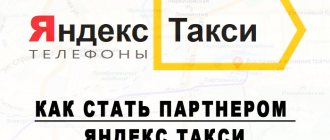Taxi taxation: what tax systems are there?
The taxi business in Russia pays taxes like any other activity related to generating income. The procedure for collecting taxes and the amount of taxes are determined by the Tax Code of the Russian Federation. Tax conditions will differ depending on the tax system used by the taxi service.
UTII is a single tax on imputed income. This system is applicable only to certain types of activities, including taxis, but this type of taxation does not apply to Moscow. All features of UTII are defined in Chapter 26.3 of the Tax Code. The amount of tax in this system is fixed; the actual amount of income is not important for its calculation: the state establishes and imputes the expected income from a business depending on the number of employees and machines.
PSN - patent taxation system. Suitable for individual entrepreneurs only. Work on this system is regulated by Chapter 26.5 of the Tax Code. To work under this system, you need to buy a patent, which will be equal to paying a tax. The amount of tax depends on the number of cars the individual entrepreneur has.
STS is a simplified taxation system. Suitable for small and medium-sized businesses, as it has restrictions on the number of employees and income. The specifics of working under the simplified tax system are recorded in Chapter 26.2 of the Tax Code. There are two options for calculating tax: 6% of income or 15% of the difference between income and expenses.
OSNO - general taxation system. It is applicable to all types of activities and forms of business organization. Set by default unless another special system is selected. Under this system, the company will pay value added tax, profit/income tax, and property tax.
Let's look at the nuances of each tax system and decide which one is right for your taxi service.
Fine for working without a license
Punishments are provided for various violations related to this area:
- the driver can be charged 1000 rubles. a fine if the salon does not have information that is established at the legislative level. For officials, the punishment will be 10 thousand rubles. Legal entities pay from 30 thousand rubles for such violations. The same principle applies to many other punishments;
- the same fines apply to those who refuse to issue their own receipt to passengers;
- 3000 rub. - the amount of the fine in the absence of a special color scheme and a lantern. Officials pay 10 thousand rubles, legal entities - up to 50 thousand rubles. This is the main disadvantage of violations - you will have to pay more than if you had followed the law from the very beginning.
For your information! The punishment for lack of a license is not defined in the article. But there is additionally Article 12.3 of the Code of Administrative Offenses of the Russian Federation. It is this document that describes situations when a passenger gets into a car without the appropriate documentation. For the driver, liability for such violations is a fine of 5,000 rubles.
Article 12.4. The Code of Administrative Offenses of the Russian Federation also deserves separate consideration. They describe the illegal use of lanterns and color schemes. They pay for such violations from 5,000 to 500 thousand rubles. depending on the status of the responsible persons. The lantern will always be confiscated as punishment in such situations. Even if we are talking about working in Yandex.Taxi.
One of the mandatory requirements after obtaining a license is regular maintenance. If the vehicle is eight years old or older, such inspections are carried out at least once every six months. Once every 12 months, if the car is from 3 to 8 years old. Taxation does not affect the resolution of this issue.
UTII taxi: cash register in operation and tax conditions
The single tax on imputed income is a special tax regime; it is convenient for taxi services in that it replaces several types of tax contributions at once, and is suitable for both legal entities and individual entrepreneurs.
For legal entity services, UTII will replace:
- corporate income tax;
- corporate property tax;
- value added tax.
Individual entrepreneur services can pay UTII instead of:
- personal income tax (NDFL);
- property tax for individuals;
- value added tax (VAT).
UTII taxi: what are the features and limitations
- The tax system is valid until 2021
- The system is available for taxi services in all cities except Moscow
- Regional authorities may separately prohibit local services from working on UTII, so you need to check the list of districts/cities in your area where work on imputation is available (scroll up this page and select the desired region)
- The service should have no more than 100 employees
- The service's fleet can contain up to 20 cars.
- For legal entities: the share of participation of other legal entities in the ownership of the authorized capital should not exceed 25%
Online cash register in a taxi on UTII
According to law 54-FZ, taxi services could begin the transition to online cash desks as early as 2020 and complete it by 2020. Only taxi services on UTII and PSN enjoyed an exceptional deferment for installing an online cash register until July 1, 2019.
But now taxis on UTII and PSN must use online cash desks and either issue printed receipts to customers or show a QR code with a link to the receipt at the end of the trip. The only exceptions are individual entrepreneurs who do not have employees. They are allowed not to use the tills until July 2021.
Thus, an online taxi cash register on UTII is needed if your service is registered as a legal entity or you, as an individual entrepreneur, have hired employees. If you are registered as an individual entrepreneur and have not hired employees, you can work without a cash register until 2021.
UTII for taxis in 2020: how to calculate and how to pay
The single tax is calculated not on real income, but on potential, imputed income and depends on the number of cars. You need to calculate a single tax for each car.
UTII taxi: calculation of car tax for a month
Basic yield * Number of passenger seats * K1-deflator * K2 * UTII rate * number of months
- UTII taxi basic profitability = 1500
- The number of passenger seats is seats without the driver's seat
- K1, The deflator coefficient depends on the inflation rate set for the year. For 2020 K1 = 1.915
- K2, The adjustment coefficient for basic profitability is established by regional legislation depending on the characteristics of the business -
- UTII rate = 15%, but in some regions it may be reduced, so also check the tax rate in the legislation of your region on the Federal Tax Service website
Taxi tax payment 2020 according to UTII
A tax return must be submitted to the regional Federal Tax Service by the 20th day of the month following the quarter. And you need to pay UTII no later than the 25th day of the month following the reporting quarter. That is, if the first quarter of the year ends in March, then the declaration must be submitted no later than April 20, and the tax must be paid no later than April 25.
UTII taxi: tax reduction
Legal entities and individual entrepreneurs can reduce the tax on the amount of insurance payments, benefits, sick leave payments, etc. for the benefit of employees. However, the amount of reduction cannot be more than 50%.
And UTII for individual taxis without employees can be reduced in full. This is possible due to the fact that such single individual entrepreneurs have the right to deduct from tax 100% of the amount of fixed contributions for pension and health insurance for themselves.
Requirements for the driver and vehicle
The current requirements for a taxi driver were approved by order of the Ministry of Transport of Russia No. 287 dated September 28, 2015. In accordance with this regulatory act, a taxi driver:
- must have all the necessary knowledge to ensure safe driving for both vehicles and pedestrians;
- be able to provide first aid;
- understand the structure of the car;
- have a Russian national driver's license;
- have at least 3 years of practical driving experience.
What should be in a taxi
The requirements for the taxi car itself are described in another legislative document - the Decree of the Government of the Russian Federation dated February 14, 2009 “On approval of the Rules for the transportation of passengers and luggage by road transport and urban ground electric transport”, paragraph 115, which says:
- A taxi car must have an orange identification lamp, which is placed on the roof of the vehicle (in common parlance, a “checker”). To indicate that the car is ready to serve passengers, the taxi driver must turn it on;
- on the back of the taxi there should be a pattern of squares placed in a checkerboard pattern;
- on the front panel, which is located to the right of the driver, the following must be indicated: the name of the legal entity or entrepreneur who provides the services (full and abbreviated);
- form and method of payment (tariffs);
- business card of the driver of the vehicle with a photo, details and contacts of the body that monitors the quality of the services provided;
It is also required that the driver have:
- waybill with notes on passing medical and technical inspection before departure on the flight;
- license for the right to transport baggage and/or passengers;
- a valid vehicle inspection certificate;
- MTPL insurance, which states that the car can be used as a taxi.
In addition to all of the above, the taxi driver is obliged to give the client a receipt for payment for the use of his services.
Taxi patent
Only services registered as individual entrepreneurs can operate under a patent. The patent tax system for taxis is convenient in that tax reporting is not required: there is no need to file a tax return, it is enough to keep a ledger of income and expenses. Tax = patent cost. A patent replaces other taxes:
- personal income tax (NDFL);
- property tax for individuals;
- value added tax (VAT).
A patent for an individual entrepreneur for a taxi: what is the limitation?
In addition to the fact that only individual entrepreneurs can use a patent, the Tax Code establishes several rules for working under this tax regime.
- An individual entrepreneur must have no more than 15 employees (including for all types of activities that he conducts)
- The annual income of individual entrepreneurs (for all types of activities) should not exceed 60 million rubles
- A patent is issued for different periods within one calendar year: from 1 to 12 months
Taxi patent: how much does a taxi patent cost and how to pay for it
The cost of a patent can be easily calculated using the online calculator on the Federal Tax Service website. It will directly depend on several indicators:
- patent term
- number of seats in a car / number of cars - the choice of indicator for calculation depends on the specific region
The procedure for paying for a patent depends on its validity period.
- If a license to operate a taxi is issued for 6 months or less, then its full cost must be paid before the expiration date.
- If a patent is issued for 6-12 months, then 1/3 of its cost is paid no later than 90 days from the start of validity, and the rest of the cost is paid until the end of the entire period of validity of the patent.
Taxi patent in 2020: how to obtain
To use a taxi patent in 2020, you need to fill out and submit an application to switch to this system to the tax service at the place of business. You can submit an application for a patent along with documents for registration of an individual entrepreneur or 10 days before the start of activity. You can receive a patent in 5 days.
Taxi patent application sample
Do taxi drivers need CCT?
The law of the Russian Federation requires all individual entrepreneurs to have cash register equipment. Although benefits are provided for entrepreneurs starting a business in the field of transport services, possession of a cash register is not necessary for them. Nevertheless, to simplify the preparation of all documents, you still need to fill out some paperwork when recording the fact of payment for services by the client. These subtle features should be taken into account by all businessmen.
Is CCP necessary for taxi drivers in 2020 and 2020?
An individual entrepreneur conquering the field of passenger transportation must have the necessary strict reporting forms available and require their completion from all transported passengers. There is currently no statutory template for taxi drivers, however, each form must contain the following details :
- full price of the service provided;
- Client's full name;
- date of service provision;
- serial number and name of the form received to pay for the carrier’s services;
- details of the authorized representative of the individual entrepreneur.
Each carrier's car must have a taximeter - a device that performs all the calculations necessary for the taxi driver and issues a receipt. The same device puts a stamp. If the obligations to fill out and issue strict reporting forms are not fulfilled, then the following penalties are imposed:
- driver fine of 1000 rubles;
- fine of an individual entrepreneur in the amount of 10,000 rubles;
- An individual entrepreneur may lose his ability to use tax benefits.
To enjoy all the benefits of the tax system, it is best to fulfill all the requirements. Compliance with the laws will not lead to a decrease in income and unnecessary expenses. With proper planning, an entrepreneur who decides to transport passengers by taxi in 2017 will recoup his expenses much faster than in other areas of business.
simplified tax system
Both organizations and individual entrepreneurs can work under the simplified taxation system. But this type of tax is more suitable for small and medium-sized businesses, as it has restrictions. You also need to remember that you can change the simplified tax system to another tax system only after the end of the tax year.
Payment modes of the simplified tax system
To pay taxes under the simplified tax system, you can choose one of two objects of taxation: income - tax is paid on the amount of income, or income minus expenses - tax is paid on the amount of income reduced by the amount of expenses incurred.
Tax must be paid in advance for each reporting period. In general, the tax period under the simplified tax system is 12 months, that is, the state receives the entire tax amount at the end of the calendar year. But to ensure uniform payments, taxes must be paid every quarter, and at the end of the year a declaration on the service’s annual income must be submitted.
Taxes under the simplified tax system must be paid by April 25, then by July 25 and by October 25. Submit a tax return and pay tax at the end of the year - before March 31 for organizations, and until April 30 for individual entrepreneurs.
It will be possible to change the object of taxation only from the next tax year and upon a written application to the Federal Tax Service.
Taxi at the object of simplified taxation system income
- The tax rate of the simplified tax system on the amount of income is 6%
- The rate may be reduced to 1% in certain regions
- The amount of income for calculating tax is taken for the reporting period: if you report for a quarter, then the tax is paid on income for the quarter, if for 9 months, then calculate the tax on income for 9 months
Taxi services under the simplified tax system income minus expenses
- The rate is equal to 15% of the difference between income and expenses for the reporting period
- In some regions the tax rate may be reduced
- Individual entrepreneurs under the simplified tax system “income minus expenses” can pay only 1% tax if the amount of taxes for the year is less than 1% of the income received for the year
An example of a year-end calculation:
- Over the year, the service received an income of 1,000,000 rubles. Expenses for the year amounted to 800,000 rubles.
- Tax base = 1,000,000 ₽ – 800,000 ₽ = 200,000 ₽
- Tax amount = 200,000 ₽ * 15% = 30,000 ₽
- The tax amount is 0.3% of the service’s annual income, which is less than 1%, which means the minimum tax rule of 1% of income applies.
- This means that the tax at the end of the year = 1,000,000 ₽ * 1% = 10,000 ₽
Individual entrepreneur on the simplified tax system for taxi 2020: conditions
Restrictions on the simplified tax system for individual entrepreneurs
- The service must have fewer than 100 employees
- Annual income should not exceed 150 million rubles
- The residual value should not exceed 150 million rubles
What taxes does the simplified tax system replace for individual entrepreneurs?
- personal income tax (NDFL)
- property tax for individuals, except for property tax based on cadastral value
- value added tax (VAT)
Reduced percentage
- In some regions of Russia, individual entrepreneurs have a reduced rate under the simplified tax system (you can check the rate for your region on the Federal Tax Service website)
- Individual entrepreneurs under the simplified tax system “income minus expenses” can pay only 1% tax on income if the amount of taxes for the year is less than 1% of the income received for the year.
- For individual entrepreneurs without employees under the simplified tax system “income”, a tax deduction for fixed insurance premiums is available in full
USN IP taxi: do you need a cash register?
We already wrote above that services should now use online cash registers and either issue printed receipts to customers or show a QR code with a link to the receipt at the end of the trip. But Law 54-FZ provides an exception for individual entrepreneurs who have not hired employees: individual entrepreneurs without employees may not use cash registers until July 1, 2021.
An online cash register for individual taxis on the simplified tax system is needed if:
- your service is registered as a legal entity;
- As an individual entrepreneur, you work with hired employees.
An online cash register for individual taxis on the simplified tax system is NOT needed if:
- you, as an individual entrepreneur, did not hire employees - you can work on the simplified tax system without a cash register until 2021.
Taxi organizations on the simplified tax system: conditions
Restrictions on the simplified tax system for organizations
- The service must have fewer than 100 employees
- Annual income should not exceed 150 million rubles
- The residual value should not exceed 150 million rubles
- A service cannot have branches
- The authorized capital of the organization cannot contain more than 25% participation of other legal entities
- To switch to the simplified tax system, the service’s income during the last year should not exceed 112.5 million rubles
What taxes does the simplified tax system replace for organizations?
- corporate income tax, except tax on dividends
- property tax for organizations, except for property tax based on cadastral value
- value added tax (VAT)
Taxi tax according to OSNO
By choosing this system, you will be required to maintain full document flow of all financial transactions, pay income tax (personal income tax), property tax and value added tax (VAT).
This system is complex both from the point of view of accounting reporting and from the point of view of the cost of its use. The main and very significant disadvantage for the organization’s activities is the difficulty in preparing and submitting reports. The need to strictly comply with all norms of accounting paperwork and the subtleties of submitting regular reports to regulatory authorities forces entrepreneurs to hire a qualified accountant and oblige drivers to write out, take into account and correctly draw up all receipts and receipts for each order. In theory this does not seem as difficult as in practice.
Taxi taxation: which system to choose
It is impossible to recommend one most profitable system; the choice depends on the specifics of running your business: how many machines, how much income, whether there are branches, in which region the service operates, etc. You also need to remember that in addition to the costs of taxes on the income of the service, you are required to pay contributions for employees: pension and health insurance, that is, the real tax costs for each service will be individual.
Which tax system to choose for a legal entity taxi
Taxi tax PSN
PSN is not suitable for legal entities, because the patent is intended only for individual entrepreneurs.
Taxi tax system OSNO
OSNO is suitable for large services with large income and a fleet of vehicles and branches.
There are no restrictions on the number of cars and employees, but it is very difficult to calculate tax and report. If it is possible to use a special system, then it is better to abandon OSNO.
Taxi on UTII or simplified tax system
UTII in its pure form is suitable only for services with their own, albeit small, fleet of vehicles, without hired individual entrepreneurs. Not suitable for Moscow services.
- If you hire individual individual entrepreneurs, then UTII will not work, use the simplified tax system.
- In Moscow there is no opportunity to work on UTII.
- Under UTII there is a limit of up to 20 cars in the fleet, up to 100 employees on staff
- You need to calculate the tax for each car.
- The tax amount can be reduced by half for contributions to pension and health insurance for employees.
The simplified tax system is suitable for a service without branches and with involved individual entrepreneurs
- Under the simplified tax system, you cannot hire more than 100 employees, and income should not exceed 150 million rubles
IP taxi: taxation system
An individual entrepreneur as a form of organizing a taxi business is convenient because various tax deductions and simplifications apply to entrepreneurs, especially for individual entrepreneurs without employees.
- Unlike a legal entity, an individual entrepreneur can work on a patent
- Does not pay tax on dividends, which means he can freely spend the remaining part of the income after paying taxes
- Tax reporting for individual entrepreneurs is simpler
- A legal address is not required for work, because the individual entrepreneur is registered at the place of residence
However, individual entrepreneurs have their own tax disadvantages: for delays, he is responsible for personal property and must pay fixed contributions for himself.
IP taxi: tax system 2020 - which tax to choose
All tax systems are available to individual entrepreneurs: patent, simplified, imputed and basic.
Tax for individual entrepreneurs on OSNO
OSNO is not profitable for individual entrepreneurs. It may only be suitable when an entrepreneur is currently buying real estate and wants to receive a personal income tax deduction from the purchase.
- There are no restrictions on the number of cars and employees
- Personal income tax 13%, VAT 20%, but entrepreneurs can receive an exemption from VAT if the income for 3 months does not exceed 2 million rubles
- not convenient for individual entrepreneurs because the tax rate for all regions is the same, while for special tax regimes in the regions there are concessions
- difficult to calculate and report
Taxation of individual entrepreneur taxi on UTII
UTII for individual entrepreneurs is suitable for small and medium-sized services not from Moscow with their own fleet (up to 20 cars) and hired drivers (not individual entrepreneurs)
- If an individual entrepreneur hires individual entrepreneurs, then purely UTII will not work; it must be used in conjunction with the simplified tax system or PSN
- Up to 20 cars in the fleet and up to 100 employed workers in the service
- Each region has its own tax rate
- Tax can be reduced by deducting contributions to pension and medical insurance funds
- Not applicable in Moscow
Individual entrepreneur taxi services tax system on patent
A patent (PSN) for an individual entrepreneur is suitable for services with a small staff of hired workers and those who attract other individual entrepreneurs. PSN is very simple to calculate - the payment for the patent is fixed and replaces reporting.
- Employees up to 15 people
- Income per year up to 60 million rubles
- No reporting required
- The cost of a patent is different in each region
- The cost of a patent is calculated by the number of machines or for each machine by the number of seats
- Not very profitable for individual entrepreneurs with their own fleet of vehicles
Individual entrepreneur on the simplified tax system: taxi 2019
The simplified tax system for individual entrepreneurs is the most convenient system if there are employees. Suitable for medium and large services without branches, suitable for cooperation with other individual entrepreneurs.
- Up to 100 employees
- Up to 150 million rubles of annual income
- It’s easy to calculate tax; you can choose the most profitable option for paying tax: on income or on the difference between income and expenses, you need to pay in advance payments every quarter
Individual entrepreneur for taxi what are the taxes 2019
Individual entrepreneurs pay several types of taxes:
- Fixed payments to pension and medical funds for yourself and for employees, if any
- Taxes according to one of the taxation systems
Let's calculate how much taxes an individual entrepreneur will pay without employees on a patent in 2020 (if the individual entrepreneur has employees, then you need to multiply the fixed contributions and the cost of the patent by the number of employees)
Fixed contributions for yourself
- Contribution to the pension fund
- with annual income of no more than 300,000 ₽ = 29,354 ₽
- with annual income of more than 300,000 ₽ = 29,354 ₽ + 1% of the excess income, but not more than 234,832 ₽
The cost of a patent for a year = approximately 18,000 ₽ for one machine
How to register an individual entrepreneur
Option 1. Open an individual entrepreneur yourself.
Visit the tax office at your place of registration. Submit the following documents to the tax office:
1. Passport of a citizen of the Russian Federation
2. Copy of passport
3. A copy of the TIN certificate
4. Receipt for payment of the state fee for registration of individual entrepreneurs: 800 rubles.
5. Application for registration of an individual as an individual entrepreneur in form P21001
. If you are not submitting in person, then you must have the documents certified by a notary.
6. Application for the use of the simplified taxation system (STS) in form No. 26.2-1
.
Possible problems: errors in filling out forms, which may result in refusal to open an individual entrepreneur. Printing copies. Correct payment of duty.
If you do not want to delve into the intricacies of opening an individual entrepreneur yourself, then contact us.
Option 2. Contact us.
| To open an individual entrepreneur, it is enough to come to our office with a Russian passport (regardless of the region of registration) and SNILS. We will complete your application in 20 minutes. The IP will open in 3-5 days. 3,000 ₽ turnkey. |
The registration procedure (collecting documents, going to authorities), and then constant reporting will take a lot of time and effort. You will have to delve into many accounting and legal subtleties, independently resolve issues with the tax office, keep records of strict reporting forms (SSR), and so on.
Our legal department
will save you from paperwork and prepare your individual entrepreneur on a turnkey basis. Our lawyers (on call 5 days a week from 10 a.m. to 5 p.m.) can take care of everything. We will not only submit documents and register individual entrepreneurs, but also:
- open a bank account
— we will create a seal for your individual entrepreneur
— we will open a taxi license for individual entrepreneurs
Our accounting department
(on call 5 days a week from 10 a.m. to 5 p.m.) they will discuss with you and offer the most beneficial tax system for you.
We have experienced accountants who will provide constant support to your individual entrepreneur: advise on any issues, prepare reports, respond to requests from the tax service, etc.
The monthly cost of our accounting support will be 1,000 rubles (fixed).
| Fraudsters ask to send documents by mail or instant messengers. We help with the registration of individual entrepreneurs officially, so we don’t ask. A visit to our office is required. |
You cannot drive a taxi without a license. On September 1, 2011, the law came into force, obliging individual entrepreneurs and transport companies for passenger transportation to have a permit. Lack of a license is a violation and grounds for a fine. For individual entrepreneurs, this amount is 10 thousand rubles.
| How to get a taxi license for an individual entrepreneur |
If you have any additional questions or suggestions regarding the schemes we offer, please contact us! We will be happy to discuss, help with the choice and make a preliminary calculation of your benefits when collaborating with our company.
| Entrust the opening and management of an individual entrepreneur to us. At the same time, get more money through legal tax optimization. |
Frequently asked questions about opening an individual entrepreneur for drivers:
1. Is it necessary to open an individual entrepreneur or LLC on your own? Can I get a license for your LLC?
Answer: in 2020, control over the issuance of taxi licenses was tightened. We will help you obtain a license only for your individual entrepreneur or LLC. There are no other options, but it is fair and legal.
2. Is it difficult for an ordinary driver to open an individual entrepreneur?
Answer: just come to our office with all the necessary documents: passport, SNILS, and your TIN. We will submit documents to the tax office and within 3-5 working days you will become an individual entrepreneur.
3. Is it possible for a foreign citizen to open an individual entrepreneur?
Answer: we help register individual entrepreneurs only for citizens of the Russian Federation. If you have a different citizenship, then you can open an individual entrepreneur yourself, having a “Temporary Residence Permit” (TRP) or “Residence Permit”.
4. If I am registered in another region, can you help me open an individual entrepreneur?
Answer: yes, we can. The procedure is the same as in question No. 2.
5. Can I send you documents by mail or messenger to open an individual entrepreneur?
Answer: only with a personal visit to the office of the person for whom the individual entrepreneur is registered.
6. How much taxes will I pay and how much will it cost the individual entrepreneur?
Answer: if you work as a driver in your own car, we recommend that you write an application to the tax office for transfer to self-employed status. Then you will only pay 5% of your income and that's it. With any other option, an individual entrepreneur will cost at least 32,000 rubles per year.
7. Will I be able to rent out my car and how much will I pay in taxes?
Answer: yes, you can take it. According to individual entrepreneurs, you must pay 32,000 ₽ within a year. What happens next will depend on the taxation system. You can get a patent for a year for 18,000 rubles. Or according to the simplified taxation system - 6% of income.
Which taxation to choose for taxi drivers and services
As a result, both for the taxi service and for the individual entrepreneur, when choosing taxation, it is better to avoid OSNO, because there are no concessions in this system. OSNO is suitable only for very large services with branches. In other cases, it is more profitable to choose one of three special tax payment regimes: PSN, simplified tax system or UTII. Which option is right for your business needs to be determined individually: the number of cars and employees, the region of work and the form of business organization matter.
Do you have a taxi business?
Download this free 14-pack and learn how to make it more effective









